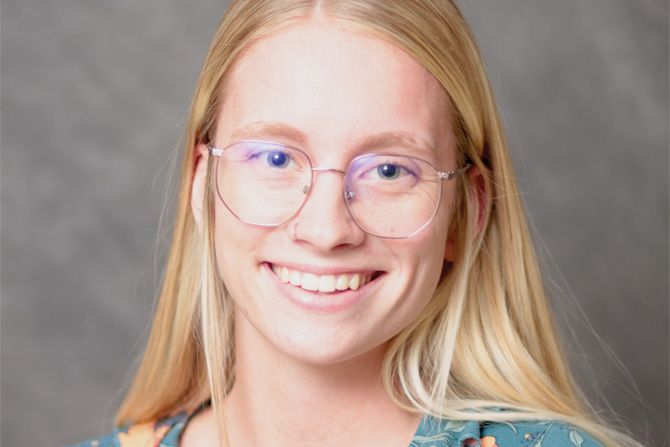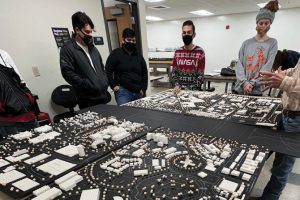Kaysi Archey is a TMCC Architecture Instructor for the ACE High School Program. She attended Western Nevada College, followed by Truckee Meadows Community College (TMCC). While at TMCC, she served as the AIAS Vice President.
Tell us about yourself.
My name is Kaysi Archey. I am the full-time TMCC and ACE High School Architecture program instructor, small business owner and dog mom to two German Shepherds. I began teaching the TMCC/ACE dual enrollment Architecture program at its start in the fall of 2020, amid the COVID pandemic. Though it was a less-than-ideal time to begin a new program, we have reached our third academic year, the final year for the first group of successful students and look forward to many more full cohorts!
My history with TMCC extends far beyond my current position. Before teaching the ACE program, I occasionally taught the two-week CEU Revit Course for TMCC while working as a project coordinator for TSK Architects, where I would aid in the drafting and design of public buildings. Additionally, I began with TSK shortly after graduating with my Residential Design and Architecture AAS from TMCC.
I am currently working toward a Bachelor of Architecture at TMCC and in the future, look forward to getting back into the professional world of architecture, practicing in different areas of design and incorporating these projects into the classroom.
Why did you go into the architectural field?
I originally began studying architecture for two reasons: I enjoyed designing livable spaces and saw a need for affordable housing in our area. Though I am now in the teaching profession of architecture and not designing homes myself, I believe I can still make an impact by making students aware of such crises at the start of their education.
What makes the architectural program at TMCC stand out?
TMCC’s Architecture Program stands out because of the community we have created within our school. Since we are a community college, we are relatively small and see that as an advantage. All architecture students know the architecture staff and vice versa. For this reason, we can support our students in smaller classes, with more availability for one-on-one conversations and by fostering their ideas through design projects.
Why academics in architecture rather than just plain architecture?
Academics in architecture is all about fostering ideas and appreciating the process of design. The students are full of enthusiasm and creativity, always wondering what’s possible in their projects. I look forward to seeing what this new generation of future designers does for our region.
From your first year teaching to now, how have the students changed?
As I mentioned, this program began during the pandemic. Students were on hybrid schedules, working from home every other day or with only half of the students at a time for the first year. To say it was a challenge to create the studio environment is putting it mildly. Now, being in class every day in our dedicated space at TMCC, the students have learned and begun to greatly appreciate their studio time and the community within it. Whether they’re working independently or working in groups, they’re always supporting and inspiring one another.
Who inspired you? How?
On a non-personal level, Zaha Hadid is an inspiration to me. As the first woman to be awarded the Pritzker Architecture Prize, she is a trailblazer for all women in design and a reminder that we can create whatever we can imagine.
Select a favorite teaching experience and explain why you selected it.
My favorite teaching experience is something I’m lucky enough to relive every year: students learning the art of presentation. As we’ve all experienced, our first project presentation is typically pretty rough. Students aren’t always confident in their design or sure of how to present their work in a way that makes sense, but every year, we present every project, and each time, there’s an incredible improvement. By the end of the first year, students’ presentation skills have improved tenfold. They know their projects well and understand what is important to present, they see the value in going through the design process, and they’re comfortable in the presentation seat. There’s also a huge improvement in the classroom community after presentations. Students realize that they’re all nervous, and they support each other. They make each other comfortable and help each other stay on track when they stumble over their words. It’s truly one of my favorite parts of every year.
If you and your students were to design a building, what type of building would it be?
If my students and I were to design any building, I think we would land on a museum. Museums are usually sophisticated on the outside and full of fun, intriguing architecture on the inside. Additionally, this would challenge students to consider the users. Museums are to appeal to every age group. How can we accommodate varying heights, interests and needs in one design?
How has teaching made you a better architect?
They say you don’t know something until you can teach it, which couldn’t be truer. In order to be successful in teaching these students I had to know what I was talking about. Though I am not a licensed architect, every day I learn something new and discover new technologies, alternative materials or methods, and even explore different perspectives because we have so many creative brains in the room at one time.
How does AIA NNs support help you to educate the architects of tomorrow?
AIA NN helps me educate our future architects because so much of my job is to inspire these students. A part of that inspiration is engaging the students in the profession of architecture early. Thanks to the AIANN, we can do this with clubs such as AIAS (which we’re hoping to begin again this year), events like Canstruction and even just by seeing award-winning work on your website that the students can identify as having seen around town or because the architect was our guest speaker. All of these things help students visualize their futures and potential in architecture









